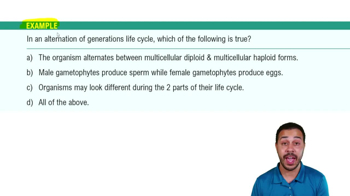Biologists think that endosymbiosis gave rise to mitochondria before plastids partly because a. the products of photosynthesis could not be metabolized without mitochondrial enzymes. b. all eukaryotes have mitochondria (or their remnants), whereas many eukaryotes do not have plastids. c. mitochondrial DNA is less similar to prokaryotic DNA than is plastid DNA. d. without mitochondrial CO2 production, photosynthesis could not occur.
In a life cycle with alternation of generations, multicellular haploid forms alternate with a. unicellular haploid forms. b. unicellular diploid forms. c. multicellular haploid forms. d. multicellular diploid forms.
 Verified step by step guidance
Verified step by step guidance
Verified Solution
Key Concepts
Alternation of Generations

Haploid and Diploid Stages

Multicellularity in Life Cycles

Which group is incorrectly paired with its description? a. diatoms—important producers in aquatic communities b. red algae—eukaryotes that acquired plastids by secondary endosymbiosis c. apicomplexans—unicellular parasites with intricate life cycles d. diplomonads—unicellular eukaryotes with modified mitochondria
According to the phylogeny presented in this chapter, which protists are in the same eukaryotic supergroup as plants? a. green algae b. dinoflagellates c. red algae d. both A and C
Based on the phylogenetic tree in Figure 28.2, which of the following statements is correct? a. The most recent common ancestor of Excavata is older than that of SAR. b. The most recent common ancestor of SAR is older than that of Unikonta. c. The most basal (first to diverge) eukaryotic supergroup cannot be determined. d. Excavata is the most basal eukaryotic supergroup.
EVOLUTION CONNECTION • DRAW IT Medical researchers seek to develop drugs that can kill or restrict the growth of human pathogens yet have few harmful effects on patients. These drugs often work by disrupting the metabolism of the pathogen or by targeting its structural features. Draw and label a phylogenetic tree that includes an ancestral prokaryote and the following groups of organisms: Excavata, SAR, Archaeplastida, Unikonta, and, within Unikonta, amoebozoans, animals, choanoflagellates, fungi, and nucleariids. Based on this tree, hypothesize whether it would be most difficult to develop drugs to combat human pathogens that are prokaryotes, protists, animals, or fungi. (You do not need to consider the evolution of drug resistance by the pathogen.)
